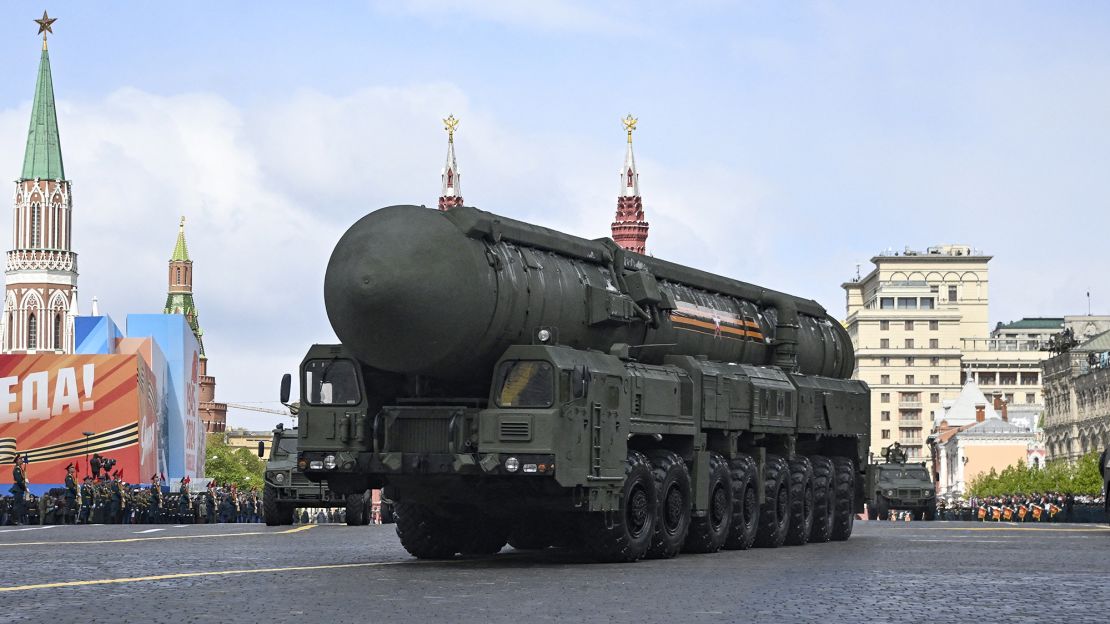Ukraine’s military has accused Russia of firing an intercontinental ballistic missile (ICBM) into its territory for the first time, marking what would be another significant escalation in the 1,000-day-old war.
Despite Kyiv’s accusation, two Western officials said that the missile launched by Russia was a ballistic missile, but not an ICBM. The Kremlin has declined to comment on the matter.
At least two people were injured in the attack on Dnipro, the head of the Ukrainian region’s military administration said. A number of buildings were also damaged.
Here’s what we know.
What is Ukraine saying?
Ukraine’s air force accused Russia of launching an intercontinental ballistic missile at Dnipro at around 5 a.m. local time, from the Astrakhan region of southern Russia.
It did not say what kind of ICBM Russia is alleged to have used, and CNN has been unable to verify this claim.
Later on Thursday, Ukraine’s Foreign Ministry spokesperson, Heorhii Tykhyi, said the country was awaiting “expert conclusions” to determine the type of missile that Russia fired at it, adding that it “had all flight characteristics of an ICBM.”
Ukraine’s military also said that an X-47M2 Kinzhal ballistic missile was launched alongside seven cruise missiles in the attack, adding that all but one of the cruise missiles were shot down.
“The other missiles didn’t cause significant consequences,” the military said.
Meanwhile, Ukrainian President Volodymyr Zelensky said the attack proves that his Russian counterpart Vladimir Putin is “so afraid, he is already using new missiles.”
“Today, our crazy neighbor has once again shown who he really is and how he despises dignity, freedom, and human life in general,” Zelensky said in a video posted to Telegram, adding that the Russian weapon had “all the characteristics: speed, altitude - of an intercontinental ballistic missile.”
What are others saying?
Two Western officials have disputed Ukraine’s version of events, saying that, although the missile launched by Russia was a ballistic missile, it was not an intercontinental one.
Speaking to reporters in Laos, where a summit of Asian nations’ defense ministers is being held, the official declined to further characterize the missile, saying its impact was still being assessed.
Meanwhile, the Kremlin’s spokesperson Dmitry Peskov declined to comment on Kyiv’s accusation on Thursday morning. In a call with reporters, Peskov said he had “nothing to say” and referred reporters to the Russian military when asked about the missile.
Why is this significant?
Ukraine’s accusation comes during a tense week in the conflict, which is now more than 1,000 days old.
This week, both US and British/French-made missiles have been fired into Russia by Ukraine, after US President Joe Biden gave Ukraine permission to use longer-range American missiles across the border.
On Tuesday, Russia’s Defense Ministry and two US officials said Ukraine had fired the US-made ATACMS into Russia for the first time.
Russia’s Defense Ministry also said its air defenses shot down two British/French-made Storm Shadow missiles, acknowledging Ukraine’s use of the longer-range weapons.
In turn, Putin updated Russia’s nuclear doctrine, with the Kremlin saying the revised military doctrine would in theory lower the bar for first use of nuclear weapons.

What is an intercontinental ballistic missile?
An intercontinental ballistic missile (ICBM) is a long-range weapon that is fired into space and then releases a warhead or warheads that reenter the atmosphere to drop on their targets.
ICBMs are considered to have a minimum range of 5,500 kilometers (3,400 miles) but some versions can go much further, more than 9,000 kilometers (5,590 miles), according to the Center for Arms Control and Non-Proliferation.
The first ICBM rocket was launched in 1957 by the then-Soviet Union. The United States followed in 1959.
Other types of ballistic missiles include intermediate range (IRBM), between 3,000 kilometers and 5,000 kilometers; medium range, between 1,000 and 3,000 kilometers; and short range, less than 1,000 kilometers.
How can Ukraine defend itself?
Ukraine uses a Patriot missile defense system supplied by the US and Germany to intercept incoming ballistic missile warheads, according to the Missile Threat Project at the Center for Strategic and International Studies.
The Patriot system is designed to engage incoming warheads, either with an exploding warhead of its own, or with kinetic interceptors – so-called “hit-to-kill” technology, which destroys the incoming warhead by striking it directly.
Patriot interceptors have a vertical range of about 20 kilometers (12 miles) and defend an area of about 15 to 20 kilometers around the battery, according to the Congressional Research Service.
But Ukraine has only a limited number of Patriots and batteries. Some cities, like the capital Kyiv, enjoy greater protection than others.
Why was Dnipro targeted?
The Dnipropetrovsk region has been a frequent target of Russian bombardment in recent months.
It borders the partially occupied Donetsk and Zaporizhzhia regions and has become a hub for people who have fled areas that are now under Russian control.
The region is now home to more than 400,000 internally displaced people. Dnipro, the fourth-largest city in Ukraine, is an important center of life in the eastern part of the country.
It is relatively close to the front lines, yet still fairly well protected by air defenses. That, plus its transportation infrastructure links to the rest of the country, makes the city a key hub in Ukraine’s war effort.

How much damage did the attack cause?
The head of Ukraine’s Dnipropetrovsk military administration said Russia was “massively attacking” the region on Thursday morning.
Two people were injured after houses were damaged, and a rehabilitation center for people with disabilities was also impacted in the attack, Serhiy Lysak said on Telegram.
There were two fires in Dnipro and “damage to an industrial enterprise,” he added.
This story has been updated with additional developments.
CNN’s Brad Lendon, Christian Edwards, Anna Chernova, Haley Britzky, Ivana Kottasová, Jerome Taylor, Kosta Gak, Antoinette Radford and Lauren Kent contributed to this reporting.



